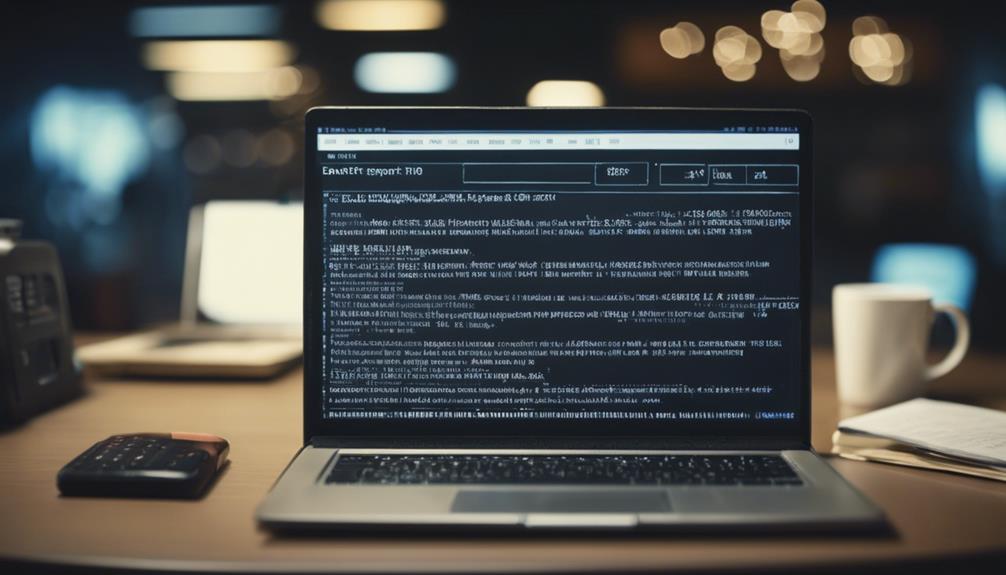As a non-resident looking to export electronics to the US, you might encounter challenges navigating trade regulations. Understanding the intricacies of US export laws is crucial for a smooth entry into the market.
From deciphering licensing requirements to grasping the nuances of compliance management, there are key elements to consider.
By exploring this guide, you will gain valuable insights into the complexities of US trade regulations and discover practical strategies to ensure your exporting endeavors meet legal standards and thrive in the competitive landscape.
Key Takeaways
- Understand EAR and licensing requirements for effective trade navigation.
- Determine ECCN and adhere to proper classification for compliance.
- Implement compliance management strategies for risk assessment and control.
- Seek expert guidance and follow BIS guidelines for successful export operations.
Understanding US Trade Regulations Overview
When navigating US trade regulations as a non-resident, understanding the comprehensive overview is crucial for compliance and successful trade activities. The Department of Commerce plays a pivotal role in regulating foreign trade through various mechanisms, including the Export Administration Regulations (EAR). These regulations control the export of dual-use items, technology, and software to safeguard national security interests. Additionally, the Department of State’s Directorate of Defense Trade Controls manages the export of defense articles and services, ensuring compliance with international trade agreements.
To engage in international trade within the US, non-residents must familiarize themselves with the intricate details of these regulations. This involves understanding the specific requirements for exporting goods, obtaining necessary licenses, and complying with documentation standards. Seeking guidance from experts or utilizing official resources can aid in navigating the complexities of US trade regulations effectively. By adhering to these guidelines, non-residents can conduct their trade activities smoothly and in accordance with the law.
Import/Export Licensing Requirements

To ensure compliance with US trade regulations as a non-resident, understanding the specific import/export licensing requirements is essential for successful trade activities.
The Department of Commerce’s Bureau of Industry and Security (BIS) plays a crucial role in regulating exports, with approximately 5% of US export transactions requiring licenses. Exporters must determine if their products fall under licensing requirements, which can be mandated by the BIS or the US Department of State for certain items.
It’s important to establish the jurisdiction of the item intended for export to ascertain whether a license is necessary. Items not listed on the Commerce Control List are classified as EAR99 and may or may not require a license for export. Being mindful of these regulations and securing an export license from the BIS when needed will help you navigate the complexities of US trade regulations efficiently, ensuring that your trade activities are conducted in full compliance with the Export Administration Regulations (EAR).
Navigating Export Administration Regulations (EAR)
Navigating the Export Administration Regulations (EAR) requires a thorough understanding of the specific guidelines governing the export of items for national security purposes in the U.S. The Department of Commerce’s Bureau of Industry and Security (BIS) administers the EAR to regulate exports of specific activities or items.
Items not listed on the Commerce Control List are classified as EAR99. To ensure export compliance, exporters must include the Export Control Classification Number (ECCN) on documentation. The ECCN helps in determining the level of control needed for a particular item. Seeking a Commodity Classification from BIS can assist in correctly identifying the ECCN for export items.
Understanding and adhering to the EAR is crucial for non-residents engaging in export activities to the U.S., as violations can result in severe penalties. By following the guidelines set forth by the BIS, exporters can navigate the complex landscape of export regulations effectively and ensure compliance with U.S. export laws.
Identifying Proper Export Control Classification Number (ECCN)

To comply with U.S. export regulations, you must understand ECCN basics, go through the ECCN determination process, and prioritize ECCN compliance.
Proper classification of items using ECCN codes is essential to identify if an export license is necessary.
Ensuring the correct ECCN on export documentation is crucial for adherence to trade regulations.
ECCN Basics Overview
Understanding the ECCN system is crucial for accurately classifying products for export control compliance. Here are key points to consider:
- ECCN Definition: ECCN stands for Export Control Classification Number, determining the need for an export license.
- Control Level: ECCN helps categorize items based on their export control requirements.
- Information Sources: Obtain ECCN details from the Commerce Control List or Bureau of Industry and Security.
- Compliance Importance: Proper ECCN classification is vital to comply with U.S. export regulations.
Ensuring the ECCN is included in export documentation is essential for adhering to export control requirements. By grasping the basics of ECCN, you take a significant step towards navigating US trade regulations effectively.
ECCN Determination Process
Begin by identifying the proper Export Control Classification Number (ECCN) for your product to ensure compliance with U.S. export regulations. The ECCN is a crucial element in navigating the complex landscape of export control regulations. By correctly classifying your product with the appropriate ECCN, you determine if a license is required for export and the level of control needed for compliance. This process is essential for meeting regulatory compliance and avoiding potential penalties. To assist you further, below is a breakdown of the ECCN determination process:
| ECCN Determination Process | Steps |
|---|---|
| Research the Commerce Control List (CCL) | Identify relevant categories |
| Review ECCN Categories | Determine the closest match for your product |
| Consult with Experts | Seek guidance for accurate classification |
| Document ECCN Assignment | Maintain records for compliance |
Understanding these steps will streamline your ECCN determination process and ensure adherence to export control requirements.
ECCN Compliance Importance
Proper compliance with ECCN classification is essential to ensure adherence to U.S. export control regulations and avoid potential violations. Understanding the Export Control Classification Number (ECCN) of your products is crucial for determining the necessary export licensing requirements.
- ECCN Classification: Helps in identifying items subject to U.S. Export Administration Regulations (EAR).
- Compliance: Ensures adherence to export control laws and regulations.
- Avoid Violations: Accurately classifying items with the correct ECCN is crucial to prevent violations.
- Information Sources: Obtain ECCN information from suppliers, manufacturers, or the Bureau of Industry and Security (BIS) for clarification.
Compliance Management Strategies

When considering compliance management strategies, it’s essential to focus on risk assessment techniques to identify and mitigate potential compliance risks.
Monitoring regulatory changes is crucial to ensure that your export compliance program remains up-to-date and aligned with current laws.
Providing training for compliance to your staff is key in fostering a culture of adherence to export control regulations.
Risk Assessment Techniques
Conducting regular risk assessments is essential for identifying potential compliance issues and vulnerabilities within your export operations. To effectively manage compliance risks, consider the following techniques:
- Utilize risk assessment tools and methodologies to prioritize compliance risks based on impact and likelihood.
- Implement internal controls and monitoring mechanisms to mitigate identified compliance risks effectively.
- Engage with legal and compliance experts to ensure your risk assessment aligns with relevant export regulations and best practices.
- Continuously review and update your risk assessment process to adapt to changes in regulations, business operations, and external factors.
Monitoring Regulatory Changes
To effectively manage compliance risks related to US trade regulations as a non-resident, establishing a robust system for monitoring regulatory changes is imperative. Stay proactive by implementing a process to regularly track updates in foreign trade regulations and compliance requirements.
Utilize resources such as the Federal Register and official government websites to monitor any amendments to export control laws that may impact non-resident trade activities. Internal protocols should be in place to promptly address and adapt to evolving compliance obligations.
Additionally, consider seeking guidance from industry associations or legal experts to ensure a comprehensive understanding of new regulatory requirements. By actively monitoring regulatory changes, you can stay ahead of compliance challenges and navigate the complex landscape of US trade regulations more effectively.
Training for Compliance
To bolster your compliance efforts in navigating US trade regulations as a non-resident, start by establishing a robust Export Compliance Program aligned with the guidelines outlined in the Export Administration Regulations (EAR).
Here’s a structured approach to enhance your compliance training:
- Develop a written compliance plan to formalize your export control processes.
- Participate in training seminars to stay updated on the latest compliance requirements.
- Maintain required record-keeping as per EAR regulations to ensure transparency.
- Seek guidance from the Bureau of Industry and Security (BIS) to tailor your compliance plan effectively.
Application Process for Licenses

When applying for export licenses, detailed information about the product, its end-use, and the destination country must be provided. The application process involves submitting supporting documentation like product specifications, end-user statements, and compliance certifications. Licensing agencies such as the Bureau of Industry and Security (BIS) or the U.S. Department of State carefully review applications to ensure compliance with regulatory requirements. The processing time for export license applications varies based on transaction complexity and the completeness of the information provided. Throughout the review process, applicants may need to engage in discussions with licensing authorities to address any queries or provide clarifications promptly.
It is crucial to be thorough and accurate when completing the application to prevent delays or rejections. Ensuring that all required information is included and that the documentation supports the intended export purpose will facilitate a smoother review process. By following the guidelines set forth by the licensing authorities and providing comprehensive details, you increase the likelihood of obtaining the necessary export licenses efficiently.
Additional Regulatory Requirements Beyond EAR

Navigating through additional regulatory requirements beyond EAR may involve compliance with the International Traffic in Arms Regulations (ITAR), particularly for certain export transactions. ITAR regulates defense-related articles, services, and technical data on the United States Munitions List (USML). This control extends to the export and temporary import of defense articles and services, imposing strict licensing requirements. For non-residents engaging in defense-related exports, understanding and adhering to ITAR regulations are imperative to comply with U.S. export control laws effectively.
- Regulation Scope: ITAR governs defense-related articles, services, and technical data listed on the US Munitions List.
- Licensing Stringency: ITAR imposes stringent licensing requirements for the export and temporary import of defense articles and services.
- Compliance Importance: Non-residents involved in defense-related exports must navigate ITAR regulations to ensure adherence to U.S. laws.
- Crucial Understanding: Understanding ITAR is crucial for non-residents exporting defense-related items to comply with the strict U.S. regulatory framework.
Customs Procedures and Tariffs

Importing goods into the United States involves complying with customs procedures and tariffs, which encompass the declaration of goods, payment of duties, and adherence to inspection processes at ports of entry. Understanding the Harmonized Tariff Schedule (HTS) is crucial as it classifies products for tariff determination in the U.S. Tariffs, taxes on imported goods, vary based on product classification and country of origin. Non-compliance with customs procedures and tariffs can lead to penalties, delays, and even the seizure of goods. To navigate these regulations successfully and avoid such consequences, familiarize yourself with the HTS codes and ensure accurate declaration and duty payment. Below is a table summarizing key points about customs procedures and tariffs:
| Topic | Description | Importance |
|---|---|---|
| Customs Procedures | Include declaration, duty payment, and inspection processes at ports of entry | Essential for compliance |
| Tariffs | Taxes imposed on imports, vary based on product classification and origin country | Impact cost of imported goods |
| Harmonized Tariff Schedule (HTS) | Classifies products for tariff determination in the U.S. | Key for accurate tariff payment |
Resources for Trade Regulation Guidance

For comprehensive guidance on trade regulations, delve into U.S. Federal laws found in the United States Code.
To aid you further in navigating U.S. trade regulations, consider the following key resources:
- eCFR.gov: This platform allows you to explore U.S. regulations related to trade in a comprehensive and easily accessible manner.
- U.S. Department of Commerce’s Country Commercial Guides: These guides provide valuable insights into specific countries’ trade regulations, helping you understand the nuances of international trade.
- U.S. Customs and Border Protection (CBP): Consult the CBP for up-to-date information on import/export regulations and procedures, ensuring compliance with customs requirements.
- Standards.gov: Explore technical regulations on this platform to ensure that your products meet the necessary standards for compliance with trade regulations.
Frequently Asked Questions
What Are the 4 Restrictions of Trade?
When you look at trade restrictions, you’ll find that export control, tariff barriers, import quotas, trade embargoes, and trade sanctions are the key players.
These measures regulate the movement of goods in and out of the U.S., impacting trade relationships and national security.
Understanding these restrictions is crucial for navigating the complex world of international trade and ensuring compliance with U.S. regulations.
What Is FTR Compliance?
When it comes to FTR compliance, you must ensure you follow the rules for export control, import duties, tariff classification, compliance requirements, and the licensing process.
Keeping up with these guidelines is crucial for accurate trade data reporting. Failure to comply can lead to penalties and restrictions on future trade activities.
Make sure you understand and adhere to FTR requirements to navigate U.S. trade regulations successfully.
How Is Trade Regulated in the United States?
Trade in the United States is regulated through laws like the Export Administration Regulations (EAR) overseen by the Bureau of Industry and Security (BIS). Most exports fall under the EAR99 category, often not needing a license. Compliance is vital for national security and trade interests.
Reporting exports over $2,500 via the Automated Export System (AES) is mandatory. Confirming foreign buyers with tools like the Consolidated Screening List (CSL) helps avoid restricted parties and ensures regulation compliance.
Do Foreign Companies Have to Follow U.S. Laws?
You absolutely must adhere to U.S. laws as a foreign company engaging in international trade. Your legal obligations include complying with U.S. trade regulations, export controls, and other regulatory requirements. Failing to do so can lead to severe consequences for your business.
Understanding and following these laws is crucial for your success in the American market and maintaining positive business relationships. Compliance is key to avoiding penalties and ensuring smooth operations in the U.S.
Conclusion
Congratulations on successfully navigating the complex world of US trade regulations for non-residents! You’ve mastered the art of understanding import/export licensing requirements, ECCN classification, and compliance management strategies.
Now, you can confidently tackle customs procedures and tariffs with ease. Who knew delving into trade regulations could be both challenging and rewarding?
Keep up the excellent work as you continue to expand your international trade ventures.